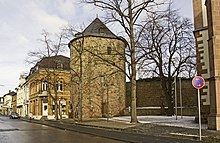Euskirchen City Museum
| Data | |
|---|---|
| place | Euskirchen |
| Art |
Local museum
|
| opening | 1992/2012 |
| operator |
City of Euskirchen
|
| management |
Heike Lützenkirchen
|
| Website | |
| ISIL | DE-MUS-432313 |
The Euskirchen City Museum shows the city history of Euskirchen from Roman times to the present day.
history
The Euskirchen City Museum was housed from 1992 to 2010 in the Dicken Turm (a defensive tower ), which was formerly part of the city wall, and an adjacent building from the Wilhelminian era in Kirchstrasse in Euskirchen. The treasure chamber of the adjacent parish church of St. Martin was also located in the thick tower . The oldest goblet from the Rhineland from 1480 could also be seen there. At the top of the tower were some motorcycles that were made by the motorcycle manufacturer Ernst Neumann-Neander . From June 8th, 2000 there was an exhibition / department on the second floor for about three years - with loans or permanent loans and donations - under the topic "Development of landscape painting in the Eifel - in the 19th and 20th centuries. 20th century ”, accompanied by readings (including Norbert Scheuer , Jochen Arlt , Lutz Rathenow , Johannes Kühn ) and lectures on the subject of“ landscape ”, as well as guided tours with active image analysis and demonstrations of artistic techniques. For reasons of space, this exhibition was closed in 2006.
In addition to the permanent exhibitions, temporary exhibitions on various subjects related to the city and cultural history were shown. A museum shop was also attached.
The city museum was closed at the old location on December 20, 2010 due to deficiencies in fire protection. The fire protection measures required for this type of use could be carried out for the registry office , which later moved into this building complex. Between Wilhelmstrasse and Neutorwall, the Kulturhof was a new building for the city library and at the same time for the city museum.
Permanent exhibition
The museum offers visitors a journey back in time through the history of the town of Euskirchen, with numerous exhibits such as legionnaires' helmets, feather hats and motorcycles. The historic city wall is integrated into the premises of the museum in the Kulturhof and is partially visible. The museum building is thus located directly between the old and new town of Euskirchen.
The starting point for the permanent exhibition is the city model. It shows the city before the start of industrialization in the 19th century. The permanent exhibition of the museum offers information about Euskirchen and its districts and presents the historical developments from Roman times to the present. In November 2015, the last part of the permanent exhibition on the topic of "Heimat-Stadt-Euskirchen" was opened. Contemporary witness reports, historical photos and objects "tell" the story of Euskirchen in the 20th century. The involvement of the residents of Euskirchen in the exhibition was fundamental for the presentation of recent history. This creates a reference to the present with numerous points of contact.
Special exhibitions
The museum regularly organizes special exhibitions on topics with historical or current references from the fields of art, culture and homeland. An accompanying program is also offered for this.
Individual evidence
- ↑ Compiled from: Conrad-Peter Joist (Hrsg.): Landscape painter of the Eifel in the 20th century . Eifelverein, Düren 1997, ISBN 3-921805-12-0 .
- ^ Manfred Lang: Eifel painter under one roof. In: Kölner Stadtanzeiger, Euskirchen, July 8, 2000.
- ↑ No more space for Schaefer. In: Kölner Stadt-Anzeiger. July 28, 2006, accessed December 5, 2017 .
- ↑ Manfred Reinnarth: Off for City Museum. The last one turns off the light. In: Kölnische Rundschau. December 23, 2010. Retrieved April 25, 2017 .
- ↑ End and new building of the museum. In: Kölner Stadt-Anzeiger. December 2, 2012, accessed December 11, 2017 .
Coordinates: 50 ° 39 ′ 32.7 " N , 6 ° 47 ′ 21.6" E
